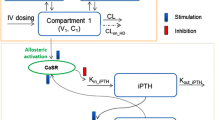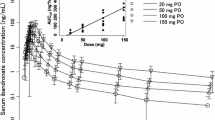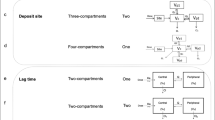Abstract.
Background: Bisphosphonates are used extensively in the management of skeletal disorders including osteoporosis. Intermittent i.v. regimens with bisphosphonates are being explored as alternatives to oral regimens. The design of therapeutic regimens with bisphosphonates is mainly based on pharmacodynamic (PD) information. A combined pharmacokinetic (PK) and PD model of bisphosphonate action can help in the design of more effective therapeutic strategies. Aim: The objective of this study was to hypothesise on a PK/PD model for intermittent i.v. pamidronate in patients with osteoporosis. Methods: Serum and urine pamidronate PKs were studied in nine patients with osteoporosis treated with pamidronate (15 mg/day via i.v. infusion) on five consecutive days. Long-term renal excretion of pamidronate was extrapolated from literature data on alendronate. The PD response (urinary hydroxyproline) was assessed in 13 patients with osteoporosis, who were given the same regimen every 3 months for 1 year. Pooled serum and urine data were fitted into a physiology-based compartment model. In order to develop a mechanistically based PK and PD model, three different Emax models were examined. Results: A physiology-based three-compartment model was able to describe pamidronate PKs with a central compartment representing the serum, a second compartment representing the bone surface and a third compartment representing deep bone. The typical effect of 1 year of 3-monthly i.v. therapy was described adequately using an Emax model, in which the effect depended on both the amount of pamidronate attached to bone (second compartment) and on the amount of pamidronate buried into bone (third compartment). Conclusions: A combined PK/PD model for pamidronate is described which incorporates the specific pharmacology of bisphosphonates. The model may be used to describe long-term effects of an i.v. pamidronate regimen in osteoporotic patients.
Similar content being viewed by others
Author information
Authors and Affiliations
Additional information
Accepted in revised form: 14 November 2001
Electronic Publication
Rights and permissions
About this article
Cite this article
Cremers, S., Sparidans, R., den Hartigh, J. et al. A pharmacokinetic and pharmacodynamic model for intravenous bisphosphonate (pamidronate) in osteoporosis. Eur J Clin Pharmacol 57, 883–890 (2002). https://doi.org/10.1007/s00228-001-0411-8
Received:
Published:
Issue Date:
DOI: https://doi.org/10.1007/s00228-001-0411-8




